Beyond Steakhouses
A New Era for Brazilian Food in the East Bay
Story, photos, and recipe by Camille Morgenstern
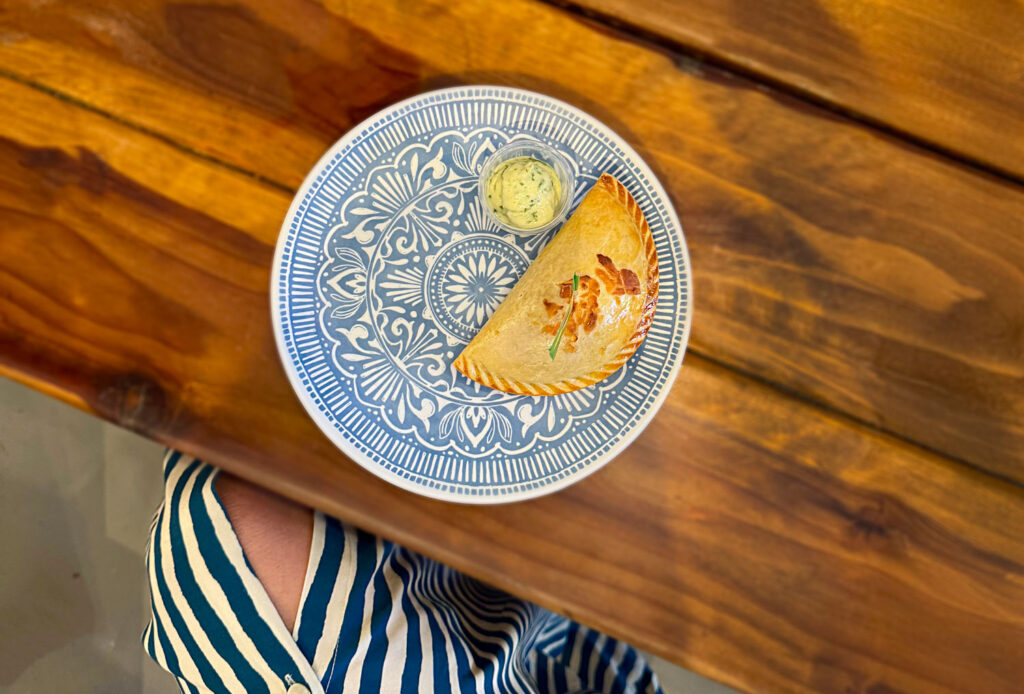
A chicken pastel at Casa do Petisco
For many, Brazilian dining is synonymous with the beloved Brazilian steakhouse, the churrascaria. Here in the Bay Area, I can always count on a churrascaria like Fogo de Chão when I’m aching for that literal slice of my home cuisine to enjoy when celebrating with friends or family. But as a Brazilian, I’ve long wished for a more diverse and complete Brazilian food scene to emerge here, one that represents my country’s many distinct regional cuisines with dishes that Brazilians eat daily and not just on special occasions.
In the Bay Area, where we are well known for our culinary sophistication and curiosity, and with approximately 15,000 Brazilians living here, it stands to reason that a more complete Brazilian food scene would emerge, and I have been delighted to find that some of my favorite foods from childhood are hiding in plain sight. I’ve found them at a handful of Brazilian gems owned and run by proud Brazilians, who go to great lengths to honor the breadth of our rich culinary heritage. I’ve found comforting versions of our trademark plate of rice and beans plus decadent street snacks and even healthy vegetarian options at neighborhood cafés that highlight a lighter side of our cuisine.
The East Bay restaurants highlighted on the following pages have one thing in common: Everything is served joyfully with the affection of our enormous Brazilian hearts. To help you delve into the unique experiences of Brazilian food, I’ve included a glossary of terms you might find unfamiliar.

Açaí: A berry from a palm that grows in the rainforests of Central and South America. It’s most commonly consumed as a purée in smoothies or bowls garnished with fruits, nuts, and other toppings. Batata palha: Matchstick potato chips served as a crunchy garnish on many typical dishes. Bife acebolado: The Brazilian take on steak frites, served with grilled onions piled high. Bobó de camarão: A chowder-like shrimp stew flavored with coconut milk and thickened with cassava. Brigadeiros: Chocolate truffles made with condensed milk that are rolled into balls and covered in sprinkles. Catupiry: A brand of soft cheese exclusive to Brazil that creates an unparalleled creamy texture when melted. Churrascaria: A Brazilian steakhouse where waiters swiftly circle the elegant dining room bringing meat served from large skewers. Coxinhas: Chicken croquettes identified by their pointy tops and filling of mashed potato, pulled chicken, and creamy cheese. Escondidinho: Our take on shepherd’s pie. Fillings might be chicken, beef, or shrimp layered under a soft yuca mash with an incredibly cheesy browned top. Farofa: Toasted bread-like crumbs made from cassava, or manioc flour, which is whole flour made from the dried and ground cassava root. Feijoada: A hearty bean stew cooked with various meats and served with rice. Goiabada: A paste made from guava and sugar. Often served with cheese. Guarana: This fruit from the Amazon also lends its name to a Brazilian soda made from guarana. Salgados: Savory pastries often served as finger food, appetizers, or a snack. Diminutive versions are called salgadinhos. Sertanejo: Indicates a dish that would be typical in the non-coastal regions of Brazil. The word is derived from sertão, which means countryside. Pão de queijo: A cheesy ball-shaped bread made from tapioca flour and low-moisture cheese. Pastel/Pasteis: Handheld deep-fried pastry/pastries with savory fillings such as ground beef, cheese, shrimp, or heart of palm. Picanha: Top sirloin. Vinagrete: a pico de gallo–style salad with diced tomatoes, onions, bell peppers, and cilantro. Yuca root: This is the primary ingredient for making cassava flour and tapioca, which are used as thickeners or flour for Brazilian pão de queijo and crepes. Yuca fries are a popular starchy side dish.
Part taproom, part casual eatery, Paulista Café at 4239 Park Boulevard in Oakland’s Glenview district welcomes the neighborhood with an extensive menu of breakfast toasts, egg dishes, sandwiches, Brazilian entrées, and healthful rice bowls. I’ve enjoyed the café’s bife acebolado, and the pico de gallo–style salad that we call vinagrete. I’ve also enjoyed Paulista’s bobó de camarão, which is served in its traditional style with rice, thinly sliced steamed collard greens, and our beloved farofa on the side. The taproom has craft beers on 24 rotating taps plus over 200 global beers in bottles. There’s also a selection of (predominantly natural) wines. Paulista’s colorful dining room has ample seating plus a few tables on the small patio to host alfresco dining. paulista510.com
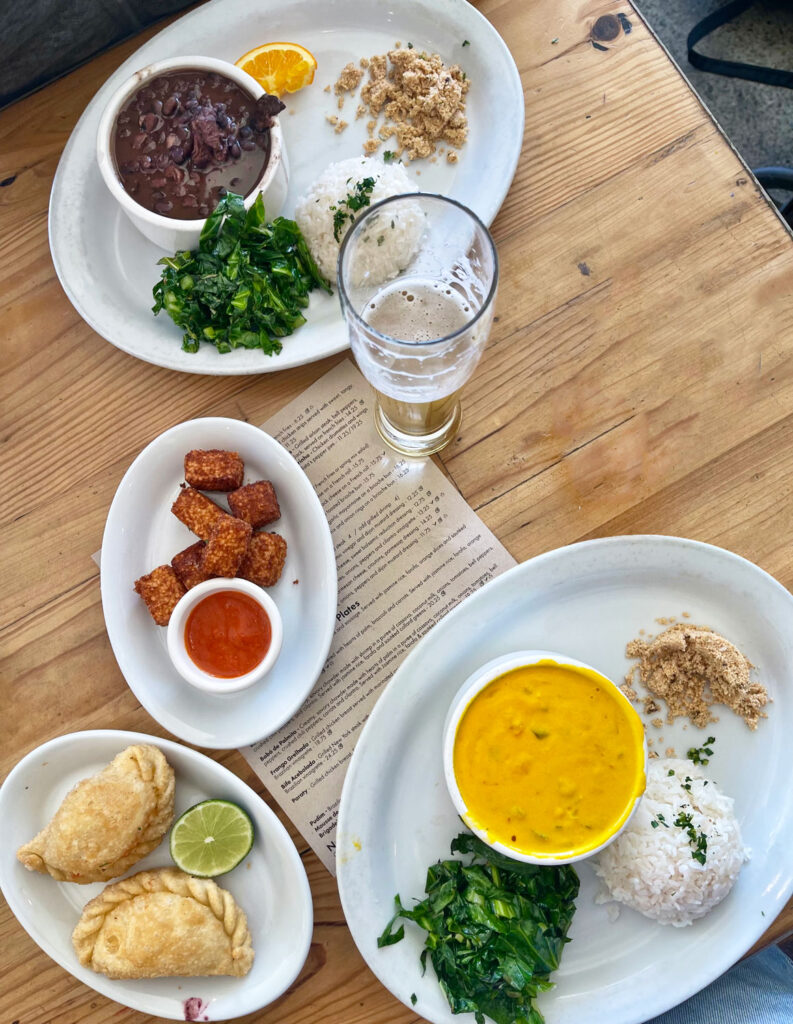
At Paulista Café in Oakland’s Glenview district, feijoada and bobó de camarão come with traditional sides of rice, collards, and farofa
Tucked away at 1233 Preservation Park Way in a historic Victorian in Oakland’s Preservation Park, Rio California has served lunch to the downtown crowd for over 20 years. “Most Brazilians are perplexed by my menu,” says owner Ney Araujo, acknowledging that the burritos and tacos may add to the confusion. But Ney transported me home as he described his inspiration from classic restaurants in his native Rio, where menus show the melting pot that is Brazil. Among his dishes are a grilled tilapia with capers and butter sauce and a seafood risotto like those cherished and made popular by Brazilian-Italians, a heritage that Ney and I share. Anyone craving a traditional Brazilian experience can’t go wrong with the feijoada, a hearty bean stew cooked with various meats and served with rice or coxinhas and a salad. riocalifornia.com
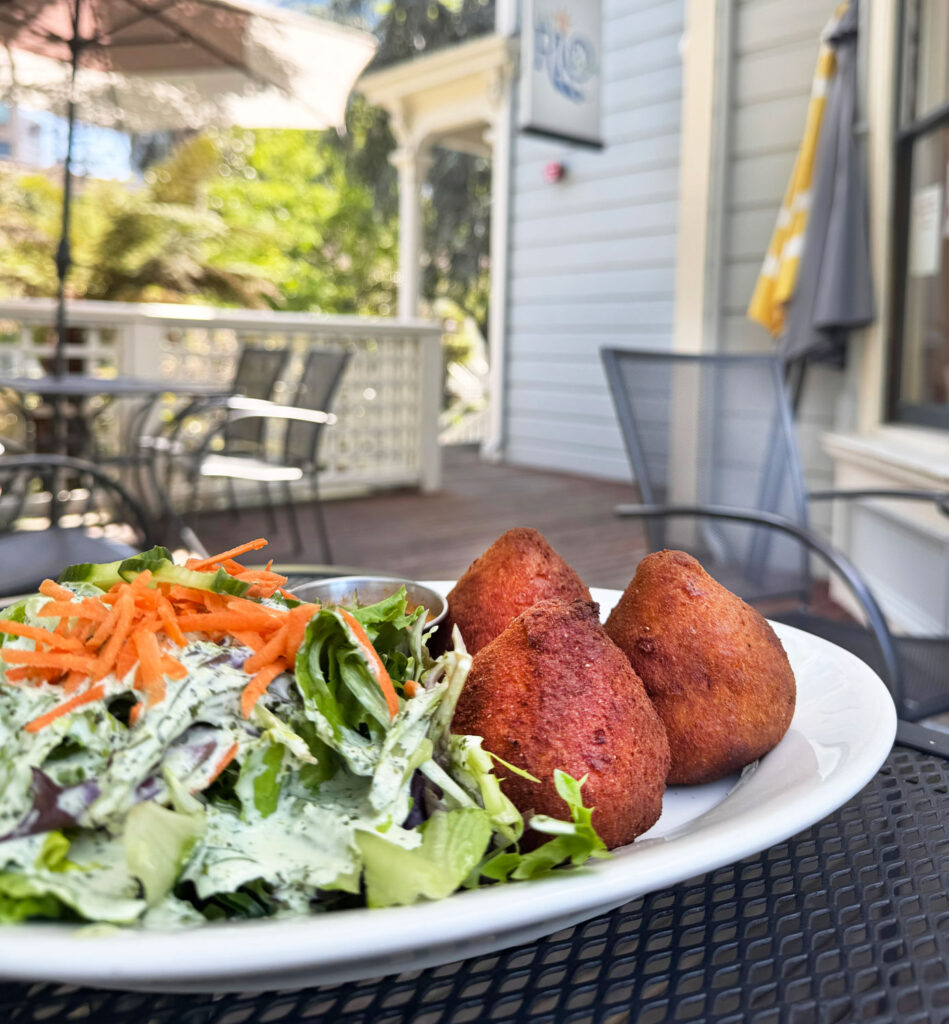
Coxinhas and a salad at Rio California in Downtown Oakland
I met Fabi Hayes of Brigachero serendipitously. While wandering the Walnut Creek Farmers’ Market, I spied the word “brigadeiros” on a poster and beelined to her stand. She saw my colorful pants covered in bananas and pineapples and did not hesitate to greet me in Portuguese. In the simplest of terms, brigadeiros are Brazilian truffles, the hallmark of any Brazilian childhood, with every birthday party hosting a table of the delightful chocolate treats adorned with sprinkles. Even to adults, they look festive, taste delicious, and always feel like a celebration. In addition to a traditional chocolate brigadeiro, Fabi creates innovative flavors such as guava, Oreo, coffee, and lemon. brigachero.com
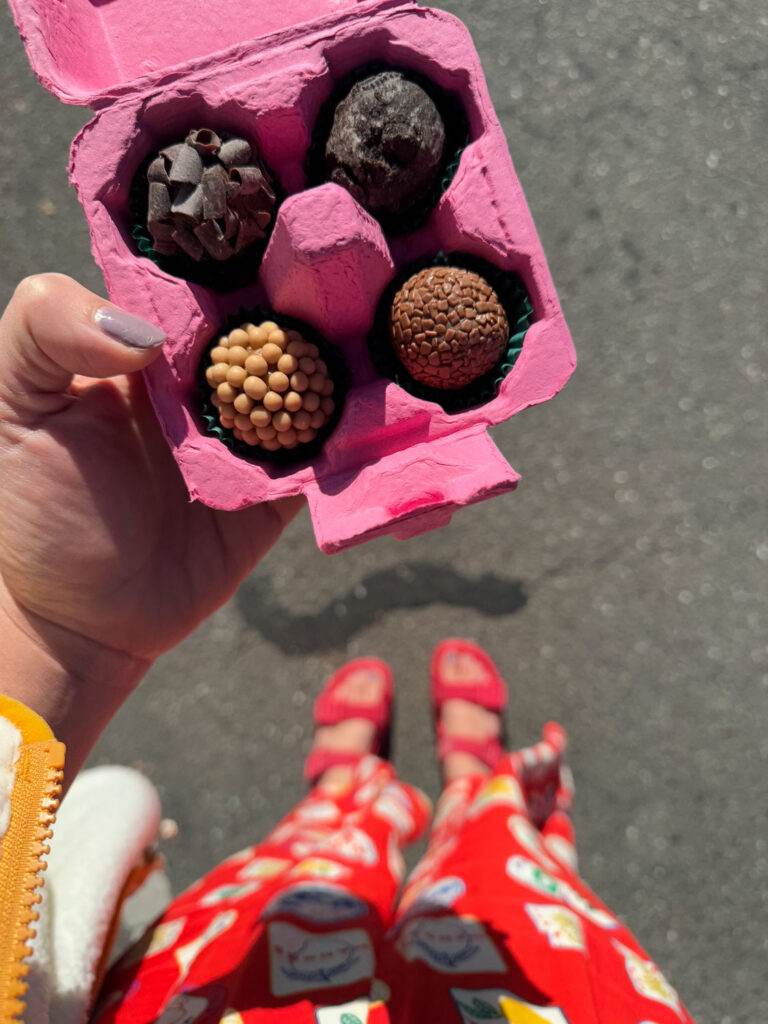
Brigadeiros from Brigachero at the Walnut Creek Farmers’ Market
Stopping in on a Saturday at lunchtime, I found the cozy dining room at Brasil Bistro (11866 San Pablo Ave, El Cerrito) bustling with guests lined up to order or browsing the tightly packed marketplace shelves. Dedicated to showcasing the rich heritage of Brazilian cuisine, Brasil Bistro offers a menu of composed dinner plates like those traditional in many Brazilian households. Here, you will find our most beloved cut of meat, the picanha, alongside rice, beans, salad, and farofa. The menu also draws inspiration from our Continental influence, so you’ll find steak or chicken parmesan and a chicken lasagna. I was pleased to find escondidinho, a Northern Brazilian dish that resembles a shepherd’s pie. brasilbistroelcerrito.com

A serving of escondidinho (Brazil’s shepherd’s pie) at Brasil Bistro in El Cerrito
Corner of Brazil (370 Hartz Ave, Danville) is very much what its name suggests: a casual café that specializes in lighter bites typical of what one might find at a stand-up snack shop on a street corner in Brazil. Owner Nickolas Guido, who hails from Belo Horizonte (capital city of Minas Gerais), is particularly proud of his açaí bowl, served here in real Brazilian style as a denser, thicker blend topped with granola, bananas, and strawberries. You can add some decadence with Nutella and/or a condensed milk drizzle. The shop is small and was very busy on a Friday lunch hour, but seating is available at the charming outdoor patio, and there is even a selection of kids’ books and toys to distract little ones. In addition to salgadinhos and sandwiches built on pão de queijo, there’s a not-to-be-missed hearty savory crepe filled with chicken and catupiry. Corner of Brazil also stocks pantry items, classic snacks, and everything you might need for a Brazilian barbecue at home. cantinhodobrazil.com
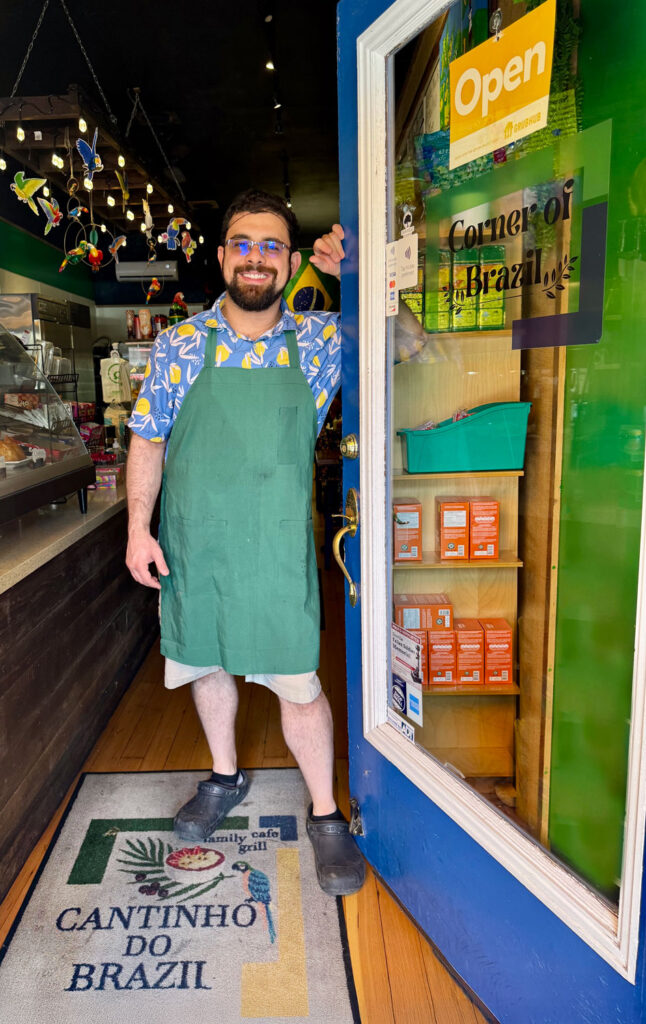
Nickolas Guido welcomes a guest to his Cantinho do Brazil (Corner of Brazil) in Danville.
At an unassuming counter inside Berkeley Organic Market at 2642 Ashby Avenue in Berkeley’s Elmwood district, Barbara Nogueira, a native of the Alagoas state capital city of Maceió, welcomes customers with the warmth that another Brazilian can instantly recognize. The small dining space of her Casa do Petisco, with its gorgeously painted mural, is the kind of eatery a Brazilian would call a lanchonete, a casual spot for snacks or a light lunch. True to form, Casa do Petisco offers counter service and seating at a few indoor and outdoor tables. You’re here to explore favorite Brazilian street snacks like the pão de queijo, assorted salgados, coxinhas, and pasteis. I love the inclusion of a vegan version of kibe, a Lebanese beef croquette popular in Brazil, made here with Impossible Beef. For lunch, the Bossa Nova chicken salad bowl was light and refreshing. The Sertanejo Bowl with braised beef, rice, corn, carrots, and salad was less heavy than it sounds and immensely satisfying. Barbara and her wife, Christene Diehr, also own and run the market, where well-stocked shelves include organic foods and a section devoted to Brazilian pantry items like goiabada, tapioca, guarana, and batata palha. casadopetisco.com
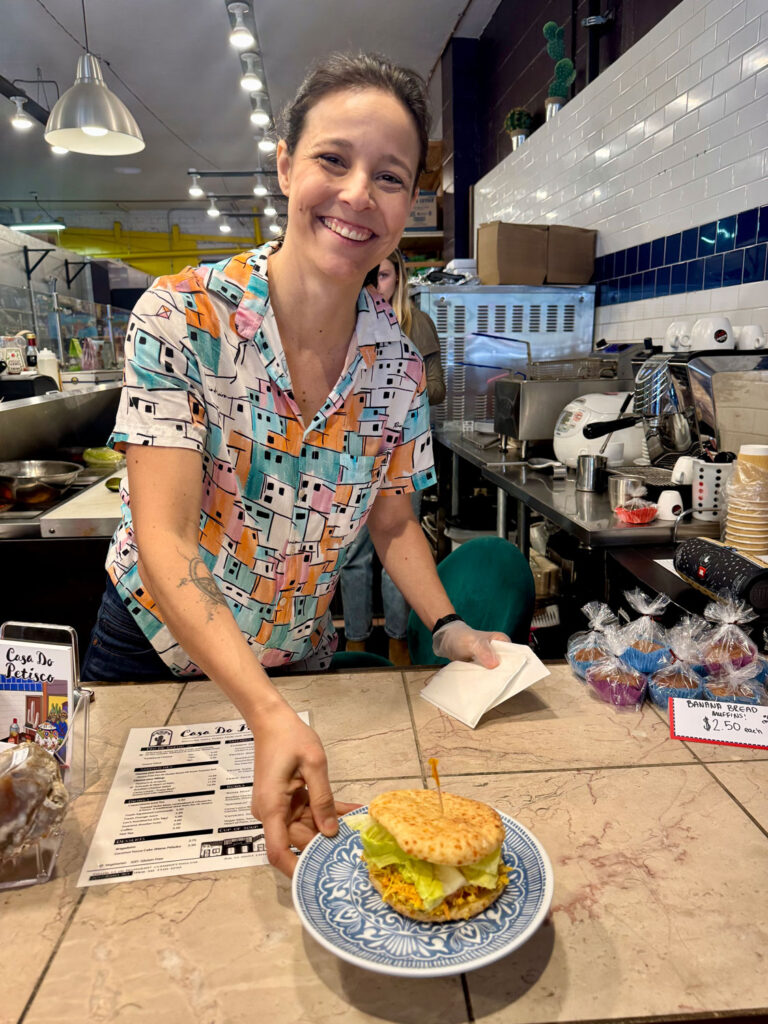
Barbara Nogueira serves a chicken salad sandwich with pão de queijo bread at Casa do Petisco in Berkeley’s Elmwood district.
More Brazilian-run food spots in the East Bay
Bossa Nova Brasil, El Cerrito ◆ Brasas do Brazil, Concord ◆ Brazuca Açaí, Richmond ◆ Espetus Churrascaria, coming soon to Concord ◆ Fogo de Chão, Emeryville ◆ Galpão Gaucho, Walnut Creek ◆ Palmetto Superfoods, Walnut Creek ◆ Pingo Doce (see page 16) ◆ Raízes do Brasil, Richmond ◆ Tempero Goiano Brazilian Coffee House Restaurant, Richmond
Brazilian Vegan Feijoada
Recipe and photo by Camille Morgenstern
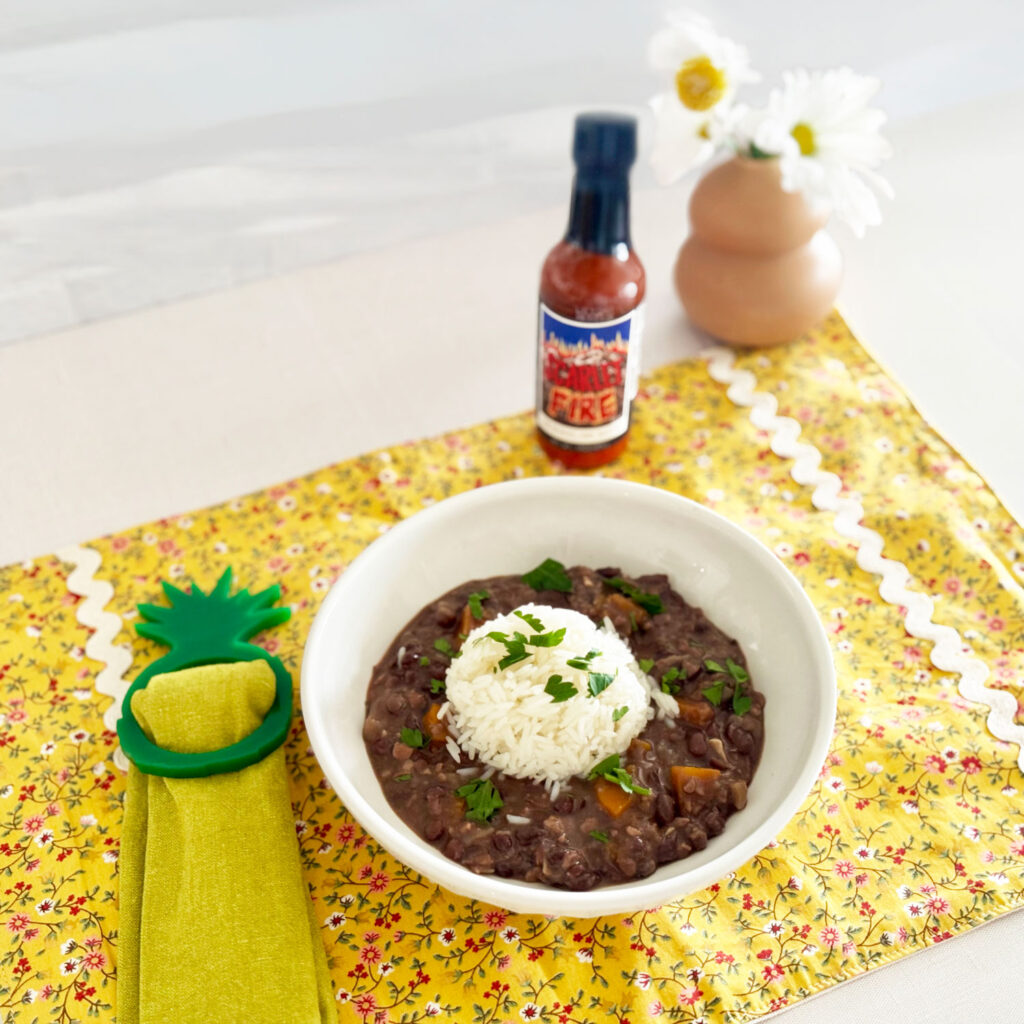
If a Brazilian childhood were defined by one sound, it would be the hissing of a pressure cooker. And if our food memories had but one smell, it would be the beautiful scent of onions and garlic being sautéed together. We refer to this base as a refogado, and it is the secret sauce to almost anything we eat, including our black beans.
Most Brazilian beans are cooked with meat, either seasoned with bacon or served in the form of feijoada, an abundant bean stew featuring various cuts of meat. This vegan feijoada takes its smoky flavors from tempeh and adds butternut squash to make it a hearty welcome to fall.
Soaking beans for up to 6 hours is crucial to achieving Brazilian-style fall-apart beans. Pressure cooking saves a lot of time, but regardless of cooking method, the final simmer with the squash will thicken your beans to perfection.
Serves 12
- 1 pound black beans (turtle variety preferred)
- 2 bay leaves 1 guajillo chile
- 8 ounces smoked tempeh, crumbled
- 7 cups water
- 2 tablespoons olive oil
- 2 cups diced onion (about 2 medium onions)
- 8 cloves garlic, minced
- 1 pound butternut squash, ½-inch dice (2 cups)
- 1 tablespoon salt
- Cooked rice for serving
- Hot sauce for topping (optional)
Soak the black beans for up to 6 hours, then drain and rinse well.
Add the soaked beans, bay leaves, chile, tempeh, and water to an Instant Pot or other pressure cooker and cook on high pressure for 40 minutes, then allow a natural release for 20 minutes. Or you could simmer beans on the stovetop for 2 hours. Remove the chile when done.
To make the refogado: Choose a soup pot or Dutch oven large enough to accommodate the cooked beans. Add olive oil and heat over medium heat. Add onion and sauté until translucent, about 6 minutes, then add garlic and cook for another 4 minutes.
Add the cooked beans to the refogado.
Add the diced squash and the salt.
Simmer for 20 minutes, until the squash is cooked and the stew has achieved a thicker consistency.
Serve over white rice with a drizzle of hot sauce for a hearty meal filled with Brazilian soul.
Note: This big batch of black beans will keep for up to 5 days and tastes even better the next day. It also freezes beautifully if you wish to stock up for colder days ahead.
Camille Morgenstern is a native of Rio de Janeiro and a culinary creative residing in the East Bay. In 2023, she launched the Rio Kitchen (theriokitchen.com), a project that shares recipes, Rio tips, and lifestyle inspo and also hosts a shop with elegant, joyful objects for the home and kitchen. She proudly engages with a community of Brazilians in the United States who are eager to feel seen and represented. She also shares her POV as a Brazilian in California on theriokitchen.substack.com.

